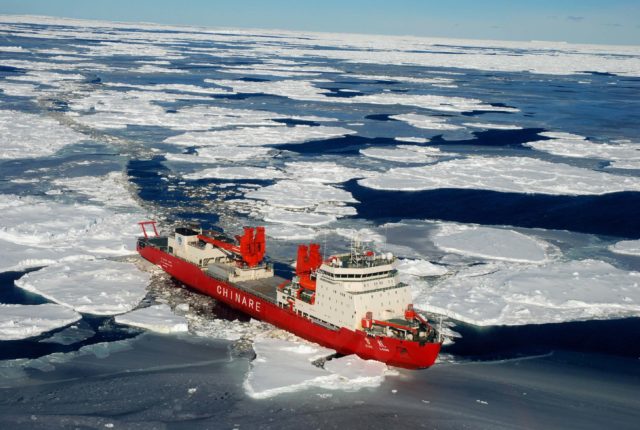
China Preparing to Bypass Russia’s Northern Sea Route in Arctic
Publication: Eurasia Daily Monitor Volume: 14 Issue: 122
By:

The Arctic icepack is retreating faster than anyone expected. But at the same time, Russia has failed to set up reliable guidance and communications networks along the Northern Sea Route (a maritime passage that mainly hugs Russia’s northern coast). These factors, combined with China’s desire to find a cheaper sea route from Asia to Europe, has led Beijing to start planning to exploit what it calls “the central seaway” in the Arctic, north of the Russian route and closer to the pole (Nezavisimaya Gazeta, October 2).
According to an extensive discussion of the Chinese plans in the October 2 edition of the Moscow daily Nezavisimaya Gazeta, Russian experts are dismissive of these ideas—some Moscow-based specialists call them “unrealistic” to the point of being an “irresponsible […] fantasy” (Nezavisimaya Gazeta, October 2). But the very fact that China is currently exploring this possibility strongly suggests that Russia will not gain either the economic or geopolitical advantages it had hoped for from the much-ballyhooed Northern Sea Route. Consequently, Beijing, not Moscow, is going to become the dominant player in Arctic transport, Nezavisimaya Gazeta concludes.
China has been among the biggest users of the Northern Sea Route in recent years because it allows Chinese companies to cut 15 days off the shipping time between Europe and Chinese ports. Over the last 12 months, six Chinese ships, taking advantage of reductions in the icepack, have made roundtrips along this route. Moscow had expected that Chinese firms would only increase this number in the future, something Russia would benefit from economically, with China having to pay its northern partner for icebreaker assistance, as well as geopolitically, since this would link China more closely with Russia.
But Beijing has concluded that the Russian route will never be large enough to meet its needs—there simply is not enough space for all the ships China hopes to have coursing between Chinese and European ports a decade from now. As a result, China has been looking at alternatives. Earlier this summer, it dispatched its Snow Dragon icebreaker on an expedition to see if it could develop a route to the north of Canada, the so-called “Northwest Passage.” The Canadian authorities, however, are opposed to an expanded Chinese presence, Nezavisimaya Gazeta writes, and have agreed only to scientific research visits not trade.
China’s goal, however, may not have been limited to an exploration of the Northwest Passage. According to the Russian-language version of Beijing’s People’s Daily, at the end of August the Snow Dragon’s trip represented something even more radical for the future of the Arctic as a trade route. It represented “the first successful transit of the central waterway of the Arctic Ocean” and thus demonstrated that a route from China to Europe far north of Russia (and possibly Canada as well) could become viable in the near future. This conclusion was backed by China’s leading specialists on the Arctic and sea trade (52hrtt.com, August 24).
Russian specialists, however, do not support that supposition. Anastasya Bashkatova of Nezavisimaya Gazeta quotes experts at the Russian Sea and River Fleet Administration as saying that Russia’s Northern Sea Route has become “traditional” and that any other routes across the polar ice cap would face serious problems. Chinese officials are simply dreaming if they think they can chart their own route, avoid paying Moscow for its icebreaker services, and have regular transportation connections with Europe via the Arctic. The voyage of China’s Snow Dragon this summer does nothing to change that, the Russian experts say.
Russia’s transportation ministry agrees. The Northern Sea Route, it asserts, “already today has reached a sufficiently good level,” and conditions and capacity will only improve in 2021, when three new Russian atomic-powered icebreakers are scheduled to come on line. And others in the Russian government, Bashkatova writes, “are not worried that China will try to avoid cooperation with Russia. On the contrary, the officials,” including Deputy Prime Minister Dmitry Rogozin, “are inviting Chinese partners ‘as guests’ and proposing that they jointly develop the Northern Sea Route.” They argue that China can obtain far more for far less money by working with Russia rather than by striking out on its own (Nezavisimaya Gazeta, October 2).
But there are at least three reasons why China may be looking ahead anyway. First and most obviously, global warming is leading to a retreat of the Arctic icepack far more rapidly than many expected and thus opening the way for more shipping channels. None of the countries interested in the Arctic have any reason to assume that the Russian route will remain the only navigable maritime course (Windowoneurasia2.blogspot.com, February 4, 2016).
Second, China is already dominating trade on the Russia route but, as its construction of more icebreakers shows, is willing to strike out on its own. It thus is becoming ever less dependent on Russia. Indeed, it will soon be able to challenge Moscow in a region many Russians see as their own backyard (The Barents Observer, December 19, 20, 21, 2016).
And third, as a result of budgetary stringencies, Moscow has had to cut back on its development of ships and shore facilities along the Northern Sea Route (see EDM, April 29, 2016; Regnum, January 25, 2017; The Barents Observer, January 24, 2017). Even this week (October 3), the Russian government has had to admit it is having serious problems with guidance systems to allow ships to navigate the Northern Sea Route (Kommersant, Profile.ru, October 3).
China, which is often noted for taking a longer view than many other countries, thus seems certain to pursue its own route or even routes across the Arctic—even if those who control the existing ones continue to be dismissive.



